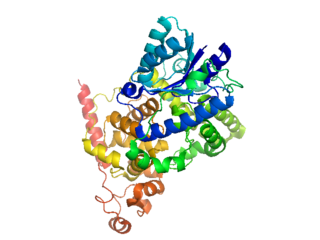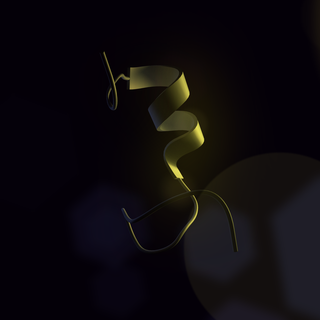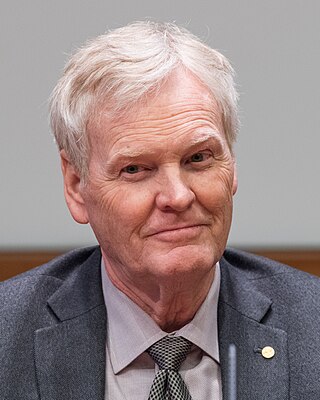Related Research Articles

A circadian rhythm, or circadian cycle, is a natural oscillation that repeats roughly every 24 hours. Circadian rhythms can refer to any process that originates within an organism and responds to the environment. Circadian rhythms are regulated by a circadian clock whose primary function is to rhythmically co-ordinate biological processes so they occur at the correct time to maximise the fitness of an individual. Circadian rhythms have been widely observed in animals, plants, fungi and cyanobacteria and there is evidence that they evolved independently in each of these kingdoms of life.
A circadian clock, or circadian oscillator, is a biochemical oscillator that cycles with a stable phase and is synchronized with solar time.

Cryptochromes are a class of flavoproteins found in plants and animals that are sensitive to blue light. They are involved in the circadian rhythms and the sensing of magnetic fields in a number of species. The name cryptochrome was proposed as a portmanteau combining the chromatic nature of the photoreceptor, and the cryptogamic organisms on which many blue-light studies were carried out.

neurofibromatosis 1 (NF1) is a gene in humans that is located on chromosome 17. NF1 codes for neurofibromin, a GTPase-activating protein that negatively regulates RAS/MAPK pathway activity by accelerating the hydrolysis of Ras-bound GTP. NF1 has a high mutation rate and mutations in NF1 can alter cellular growth control, and neural development, resulting in neurofibromatosis type 1. Symptoms of NF1 include disfiguring cutaneous neurofibromas (CNF), café au lait pigment spots, plexiform neurofibromas (PN), skeletal defects, optic nerve gliomas, life-threatening malignant peripheral nerve sheath tumors (MPNST), pheochromocytoma, attention deficits, learning deficits and other cognitive disabilities.

CLOCK is a gene encoding a basic helix-loop-helix-PAS transcription factor that is known to affect both the persistence and period of circadian rhythms.
Timeless (tim) is a gene in multiple species but is most notable for its role in Drosophila for encoding TIM, an essential protein that regulates circadian rhythm. Timeless mRNA and protein oscillate rhythmically with time as part of a transcription-translation negative feedback loop involving the period (per) gene and its protein.
Period (per) is a gene located on the X chromosome of Drosophila melanogaster. Oscillations in levels of both per transcript and its corresponding protein PER have a period of approximately 24 hours and together play a central role in the molecular mechanism of the Drosophila biological clock driving circadian rhythms in eclosion and locomotor activity. Mutations in the per gene can shorten (perS), lengthen (perL), and even abolish (per0) the period of the circadian rhythm.

The PER1 gene encodes the period circadian protein homolog 1 protein in humans.
In molecular biology, an oscillating gene is a gene that is expressed in a rhythmic pattern or in periodic cycles. Oscillating genes are usually circadian and can be identified by periodic changes in the state of an organism. Circadian rhythms, controlled by oscillating genes, have a period of approximately 24 hours. For example, plant leaves opening and closing at different times of the day or the sleep-wake schedule of animals can all include circadian rhythms. Other periods are also possible, such as 29.5 days resulting from circalunar rhythms or 12.4 hours resulting from circatidal rhythms. Oscillating genes include both core clock component genes and output genes. A core clock component gene is a gene necessary for to the pacemaker. However, an output oscillating gene, such as the AVP gene, is rhythmic but not necessary to the pacemaker.
Pigment dispersing factor (pdf) is a gene that encodes the protein PDF, which is part of a large family of neuropeptides. Its hormonal product, pigment dispersing hormone (PDH), was named for the diurnal pigment movement effect it has in crustacean retinal cells upon its initial discovery in the central nervous system of arthropods. The movement and aggregation of pigments in retina cells and extra-retinal cells is hypothesized to be under a split hormonal control mechanism. One hormonal set is responsible for concentrating chromatophoral pigment by responding to changes in the organism's exposure time to darkness. Another hormonal set is responsible for dispersion and responds to the light cycle. However, insect pdf genes do not function in such pigment migration since they lack the chromatophore.

Cycle (cyc) is a gene in Drosophila melanogaster that encodes the CYCLE protein (CYC). The Cycle gene (cyc) is expressed in a variety of cell types in a circadian manner. It is involved in controlling both the sleep-wake cycle and circadian regulation of gene expression by promoting transcription in a negative feedback mechanism. The cyc gene is located on the left arm of chromosome 3 and codes for a transcription factor containing a basic helix-loop-helix (bHLH) domain and a PAS domain. The 2.17 kb cyc gene is divided into 5 coding exons totaling 1,625 base pairs which code for 413 aminos acid residues. Currently 19 alleles are known for cyc. Orthologs performing the same function in other species include ARNTL and ARNTL2.
Doubletime (DBT) also known as discs overgrown (DCO) is a gene that encodes the double-time protein (DBT) in fruit flies. The gene was first identified and characterized in 1998 by Michael Young and his team at Rockefeller University.

Michael Morris Rosbash is an American geneticist and chronobiologist. Rosbash is a professor and researcher at Brandeis University and investigator at the Howard Hughes Medical Institute. Rosbash's research group cloned the Drosophila period gene in 1984 and proposed the Transcription Translation Negative Feedback Loop for circadian clocks in 1990. In 1998, they discovered the cycle gene, clock gene, and cryptochrome photoreceptor in Drosophila through the use of forward genetics, by first identifying the phenotype of a mutant and then determining the genetics behind the mutation. Rosbash was elected to the National Academy of Sciences in 2003. Along with Michael W. Young and Jeffrey C. Hall, he was awarded the 2017 Nobel Prize in Physiology or Medicine "for their discoveries of molecular mechanisms controlling the circadian rhythm".

Jeffrey Connor Hall is an American geneticist and chronobiologist. Hall is Professor Emeritus of Biology at Brandeis University and currently resides in Cambridge, Maine.

Michael Warren Young is an American biologist and geneticist. He has dedicated over three decades to research studying genetically controlled patterns of sleep and wakefulness within Drosophila melanogaster.
Hitoshi Okamura is a Japanese scientist who specializes in chronobiology. He is currently a professor of Systems Biology at Kyoto University Graduate School of Pharmaceutical Sciences and the Research Director of the Japan Science Technology Institute, CREST. Okamura's research group cloned mammalian Period genes, visualized clock oscillation at the single cell level in the central clock of the SCN, and proposed a time-signal neuronal pathway to the adrenal gland. He received a Medal of Honor with Purple Ribbon in 2007 for his research and was awarded Aschoff's Ruler for his work on circadian rhythms in rodents. His lab recently revealed the effects of m6A mRNA methylation on the circadian clock, neuronal communications in jet lag, and the role of dysregulated clocks in salt-induced hypertension.
Jeffrey L. Price is an American researcher and author in the fields of circadian rhythms and molecular biology. His chronobiology work with Drosophila melanogaster has led to the discoveries of the circadian genes timeless (tim) and doubletime (dbt), and the doubletime regulators spaghetti (SPAG) and bride of doubletime (BDBT).

Drosophila circadian rhythm is a daily 24-hour cycle of rest and activity in the fruit flies of the genus Drosophila. The biological process was discovered and is best understood in the species Drosophila melanogaster. Other than normal sleep-wake activity, D. melanogaster has two unique daily behaviours, namely regular vibration during the process of hatching from the pupa, and during mating. Locomotor activity is maximum at dawn and dusk, while eclosion is at dawn.
Ravi Allada is an Indian-American chronobiologist studying the circadian and homeostatic regulation of sleep primarily in the fruit fly Drosophila. He is the Edward C. Stuntz Distinguished Professor of Neuroscience and Chair of the Department of Neurobiology at Northwestern University. Working with Michael Rosbash, he positionally cloned the Drosophila Clock gene. In his laboratory at Northwestern, he discovered a conserved mechanism for circadian control of sleep-wake cycle, as well as circuit mechanisms that manage levels of sleep.
Jet or Jetlag is a gene discovered in Drosophila and other insects. They are a part of the SCF family of ubiquitin ligases that plays a huge role in the circadian pathway by controlling the degradation of TIM, a circadian regulatory protein. The gene plays an important role in resetting the circadian clock by transmitting light from CRY to TIM. Jetlag mutants have been found to impede re-entrainment due to significantly reduced ability to degrade TIM. The F-box protein of the FBXL family named FBXL15 is JET's mammalian homolog.
References
- ↑ "Home | Sehgal Lab | Perelman School of Medicine at the University of Pennsylvania". www.med.upenn.edu.
- 1 2 3 Pennsylvania scientist played role in research that won 2017 Nobel Prize https://www.pennlive.com/news/2017/10/pennsylvania_scientist_contrib.html
- ↑ Sehgal, Amita; Mignot, Emmanuel (July 2011). "Genetics of Sleep and Sleep Disorders". Cell. 146 (2): 194–207. doi:10.1016/j.cell.2011.07.004. PMC 3153991 . PMID 21784243.
- ↑ "Amita Sehgal, PHD, on Using Fruit Flies for Sleep Research". 11 July 2019.
- ↑ Roy, Sree (4 September 2016). "How Time Flies: Amita Sehgal, PhD | Sleep Review".
- 1 2 3 4 "Time, Flies". The Scientist Magazine®.
- ↑ Sehgal, A.; Price, J. L.; Man, B.; Young, M. W. (18 March 1994). "Loss of circadian behavioral rhythms and per RNA oscillations in the Drosophila mutant timeless". Science. 263 (5153): 1603–1606. Bibcode:1994Sci...263.1603S. doi:10.1126/science.8128246. PMID 8128246.
- ↑ Myers, Michael P.; Wager-Smith, Karen; Wesley, Cedric S.; Young, Michael W.; Sehgal, Amita (3 November 1995). "Positional Cloning and Sequence Analysis of the Drosophila Clock Gene, timeless". Science. 270 (5237): 805–808. Bibcode:1995Sci...270..805M. doi:10.1126/science.270.5237.805. PMID 7481771. S2CID 3211623.
- ↑ Sehgal, Amita; Rothenfluh-Hilfiker, Adrian; Hunter-Ensor, Melissa; Chen, Yifeng; Myers, Michael P.; Young, Michael W. (3 November 1995). "Rhythmic Expression of timeless: A Basis for Promoting Circadian Cycles in period Gene Autoregulation". Science. 270 (5237): 808–810. Bibcode:1995Sci...270..808S. doi:10.1126/science.270.5237.808. PMID 7481772. S2CID 38151127.
- ↑ Hunter-Ensor, Melissa; Ousley, Andrea; Sehgal, Amita (March 1996). "Regulation of the Drosophila Protein Timeless Suggests a Mechanism for Resetting the Circadian Clock by Light". Cell. 84 (5): 677–685. doi: 10.1016/S0092-8674(00)81046-6 . PMID 8625406. S2CID 15049039.
- ↑ Sathyanarayanan, Sriram; Zheng, Xiangzhong; Xiao, Rui; Sehgal, Amita (February 2004). "Posttranslational Regulation of Drosophila PERIOD Protein by Protein Phosphatase 2A". Cell. 116 (4): 603–615. doi: 10.1016/S0092-8674(04)00128-X . PMID 14980226. S2CID 295780.
- 1 2 Williams, Julie A.; Su, Henry S.; Bernards, Andre; Field, Jeffrey; Sehgal, Amita (21 September 2001). "A Circadian Output in Drosophila Mediated by Neurofibromatosis-1 and Ras/MAPK". Science. 293 (5538): 2251–2256. Bibcode:2001Sci...293.2251W. doi:10.1126/science.1063097. PMID 11567138. S2CID 23175890.
- ↑ Koh, Kyunghee; Zheng, Xiangzhong; Sehgal, Amita (23 June 2006). "JETLAG Resets the Drosophila Circadian Clock by Promoting Light-Induced Degradation of TIMELESS". Science. 312 (5781): 1809–1812. Bibcode:2006Sci...312.1809K. doi:10.1126/science.1124951. PMC 2767177 . PMID 16794082.
- ↑ Heisenberg, Martin (April 2003). "Mushroom body memoir: from maps to models". Nature Reviews Neuroscience. 4 (4): 266–275. doi:10.1038/nrn1074. PMID 12671643. S2CID 5038386.
- ↑ Joiner, William J.; Crocker, Amanda; White, Benjamin H.; Sehgal, Amita (June 2006). "Sleep in Drosophila is regulated by adult mushroom bodies". Nature. 441 (7094): 757–760. Bibcode:2006Natur.441..757J. doi:10.1038/nature04811. PMID 16760980. S2CID 4323353.
- ↑ Koh, Kyunghee; Joiner, William J.; Wu, Mark N.; Yue, Zhifeng; Smith, Corinne J.; Sehgal, Amita (18 July 2008). "Identification of SLEEPLESS, a Sleep-Promoting Factor". Science. 321 (5887): 372–376. Bibcode:2008Sci...321..372K. doi:10.1126/science.1155942. PMC 2771549 . PMID 18635795.
- ↑ "HHMI Bulletin Spring 2014: Around the Clock". Howard Hughes Medical Institute. Retrieved 2015-04-09.
- ↑ Kayser, Matthew S.; Yue, Zhifeng; Sehgal, Amita (18 April 2014). "A Critical Period of Sleep for Development of Courtship Circuitry and Behavior in Drosophila". Science. 344 (6181): 269–274. Bibcode:2014Sci...344..269K. doi:10.1126/science.1250553. PMC 4479292 . PMID 24744368.
- ↑ Makin, Simon (1 November 2019). "Deep Sleep Gives Your Brain a Deep Clean". Scientific American.
- ↑ Artiushin, Gregory; Zhang, Shirley L; Tricoire, Hervé; Sehgal, Amita (26 November 2018). "Endocytosis at the Drosophila blood–brain barrier as a function for sleep". eLife. 7: e43326. doi: 10.7554/eLife.43326 . PMC 6255390 . PMID 30475209.
- ↑ Zhang, Shirley L.; Yue, Zhifeng; Arnold, Denice M.; Artiushin, Gregory; Sehgal, Amita (March 2018). "A Circadian Clock in the Blood-Brain Barrier Regulates Xenobiotic Efflux". Cell. 173 (1): 130–139.e10. doi:10.1016/j.cell.2018.02.017. PMC 5866247 . PMID 29526461.
- ↑ Cavanaugh, Daniel J.; Geratowski, Jill D.; Wooltorton, Julian R.A.; Spaethling, Jennifer M.; Hector, Clare E.; Zheng, Xiangzhong; Johnson, Erik C.; Eberwine, James H.; Sehgal, Amita (April 2014). "Identification of a Circadian Output Circuit for Rest:Activity Rhythms in Drosophila". Cell. 157 (3): 689–701. doi:10.1016/j.cell.2014.02.024. PMC 4003459 . PMID 24766812.
- ↑ Toda, Hirofumi; Williams, Julie A.; Gulledge, Michael; Sehgal, Amita (1 February 2019). "A sleep-inducing gene, nemuri, links sleep and immune function in Drosophila". Science. 363 (6426): 509–515. Bibcode:2019Sci...363..509T. doi:10.1126/science.aat1650. PMC 6505470 . PMID 30705188.
- ↑ Lambert, Jonathan (31 January 2019). "Sick And Tired? Scientists Find Protein That Puts Flies To Sleep And Fights Infection". NPR.
- ↑ Johnson, Greg (ed.). "Amita Sehgal". Penn Current. Archived from the original on September 8, 2015. Retrieved April 8, 2015.
- ↑ National Academy of Sciences Members and Foreign Associates Elected, News from the National Academy of Sciences, National Academy of Sciences, May 3, 2016, archived from the original on May 6, 2016, retrieved 2016-05-14.
- ↑ "David Geffen School of Medicine at UCLA names 2020 Switzer Prize recipient". UCLA.